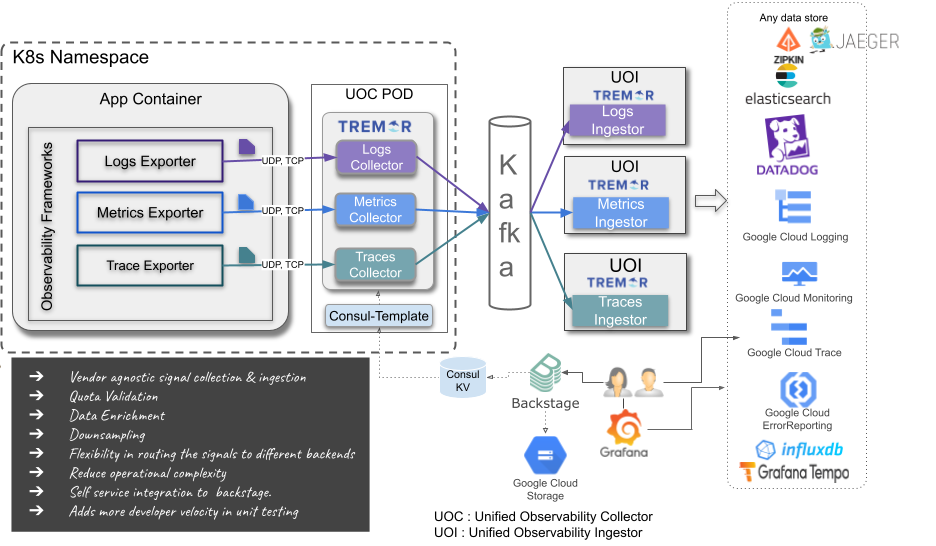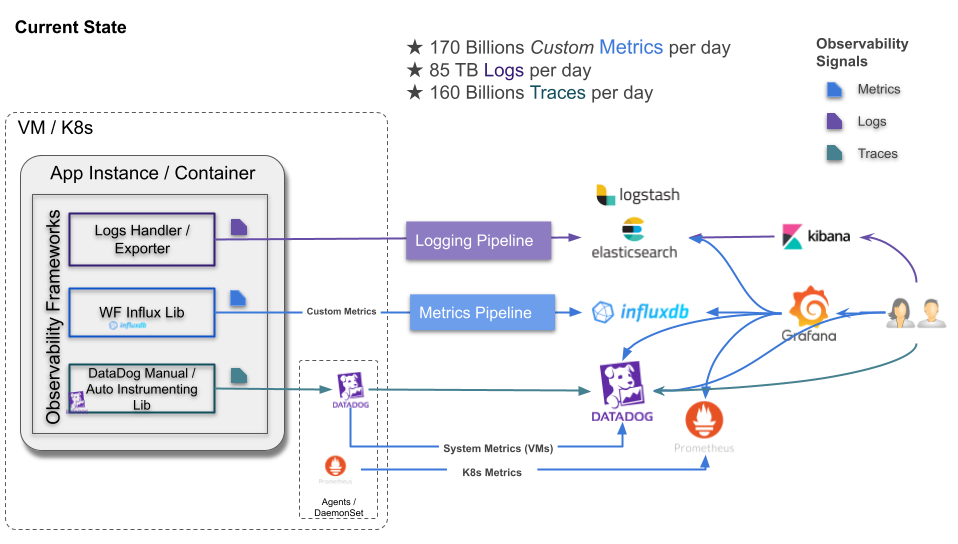As Wayfair's technology organization modernizes its infrastructure services to meet new volumetric peaks they continually adapt, adopt and atrophy out systems and services.
This is particularly difficult with shared infrastructure and services that are ever-present but seldom seen by many of the engineers in the organization.
The rise of OpenTelemetry provides an opportunity for developers to consolidate on SDKs that are consistent across programming languages and frameworks. For our SRE's and operators it offers ease of integration and ease of migration of services.
Tremor is a core enabling component of Wayfair's migration strategy. Tremor supports but is endpoint, protocol and service agnostic. This allows our operational teams to switch from on-premise to cloud native services with minimal coordination with others.
This also allows switching from in-house to managed or out of the box services supported by cloud providers.
Moving 1000s of developers to a new technology stack when you are operating continuously with no downtime and at a large scale is hard.
Identified Need
Tremor emerged from production needs in existing systems, specifically in the logging and metrics or observability domains in a large hypergrowth and heavily speciated and specialized production environment that operates 24x7x365.
As this infrastructure is migrated from a largely on-premise data-centre based environment to a cloud native environment and the wider technology organization it operates within doubles in size, change is inevitable. You can bet your roadmap on it.
One great emerging de facto standard is the observability sub-domain that cloud-native computing is propelling forward with standards such as the CNCF’s OpenTelemetry.
Tremor added initial support for OpenTelemetry in February 2021.
For decades, observability - whether logging, metrics or distributed tracing has been common. But, lacking in a unified approach, lacking in a core set of interoperable and interworking standards.
OpenTelemetry has good support for capturing and distributing logs, metrics and trace spans. It has sufficient out of the box to suit the most common needs, most of the time. It affords developers an opportunity to rationalize libraries and frameworks around shared concepts, shared understanding and shared effort. This is especially valuable in large, complex production operations such as Wayfair’s eCommerce production estate.
Languages and platforms change over time. System and component infrastructure are continuously evolving. As SaaS environments continue to evolve and innovate new forms of observability; or production operations, system reliability engineers or network operations teams who often need to move faster than the pace of application or infrastructure developers can develop new software and systems - this is a hard problem.
By targeting OpenTelemetry - developers can depend on a consistent set of SDKs for most common observability needs. Production focused teams can depend on a consistent wire-format and protocol allowing them to move from data-centre to the cloud, and rewire the infrastructure and services just in time.
Through OpenTelemetry, we can normalize the concepts, the code and the inner workings of our cloud-based systems and services - whilst introducing far more flexibility than ever before as observability services and software vendors provide a standards-based and interoperable path.
It is a win-win for all concerned.
Required Outcome

In production at Wayfair, logging and metrics data distribution pipelines are all handled by tremor. With OpenTelemetry, distributed tracing can now be standardized across our production estate.
Solution
Standardize an Tremor and OpenTelemetry together.
Characteristics
The introduction of OpenTelemetry allows developers to standardize on Observability in applications, services and code for logging, metrics and distributed tracing. As OpenTelemetry is natively supported in tremor, it means only minor configuration changes to our existing logging and metrics services.

With OpenTelemetry, distributed tracing can benefit from the same traffic shaping and adaptive rate limiting as the rest of our observability stack. The unification of the source, collector and distribution tiers via kafka provides scalable and recoverable telemetry shipping and distribution.
Tremor adds adaptive load shedding and traffic shaping that are tunable in production. Tremor also allows legacy observability frameworks to co-exist with OpenTelemetry for a gradual migration across the programming languages and frameworks in production use. Finally, tremor enables multiple downstream services to participate in the overall solution.
As a heterogeneous ecosystem of interconnected services - the unified observability platform based on tremor has no preferred upstream or downstream endpoint. It is system and service agnostic. It is bendable.
This allows teams that prefer the GCP ecosystem to normalize to those native services for visualization, debugging and troubleshooting. For our ElasticSearch population, Elastic’s APM may be a better alternative. For other teams, and our operational staff and folk with more ad hoc needs - DataDog may be preferable.
It’s a cloud native decentralized rock’n’roll observability world out there. Getting 5000 and growing engineers to choose a single observability path is impossible. So, as the population cannot bend, the unified observability leans on tremor for this purpose.
As improved services, frameworks and methods are onboarded our tremor-based systems can be incrementally adjusted to meet changing demands.
Insights
This application of tremor does not introduce new features or capabilities per se.
However, it is the first unified tremor-based system that spans the entire observability spectrum. It centralizes common capabilities and facilities for greater operational freedom, whilst decentralizing the point-to-point endpoint connectivity for the widest applicability across our production estate.
As tremor exposes OpenTelemetry as a client, and as an embedded server - it is effectively used to disintermediate, interpose and intework with legacy environments and to standardise on OpenTelemetry.
It does this as an incremental update. Existing users have time to migrate their systems to the new OpenTelemetry-based best-practice. Existing processes, practices and battle-tested systems are maintained.
Operators have better tools to manage the production estate and to tune capacity, performance and cost.
This is also the first tremor-based system where tremor is a key architectural primitive allowing our observability community to bend to the changing needs of our development and operational community with minimal effort, and at short notice.
Conclusion
As tremor expands to new domains such as search, service orchestration and supply-chain and logistics to name but a few - our early adopters in the logging domain have evolved from using tremor as a point solution for traffic shaping - to building our entire observability infrastructure based on tremor.
New domains will extend tremor’s capabilities in multi-participant transaction processing and distributed orchestration. The now unified observability domain will further expand and extract capabilities that enhance modularity and flexibility of tremor to build large distributed systems with a relatively simple and easy to program and growing set of languages designed for large-scale event-based processing.